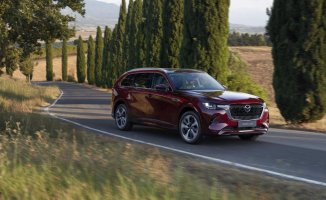The progression that plug-in hybrids have experienced in recent years has placed them in a position that is difficult to displace. They have it all; They combine efficiency and sustainability with comfort and smooth running, but they are also functional and exciting in terms of performance, and extraordinarily flexible and versatile in daily use.
Without a doubt, they intelligently and in the best way combine the virtues of electrified driving and combustion engines, but without “suffering” the less desirable consequences of both technologies: on the one hand, anxiety about autonomy and the limitations of an electric vehicle. pure, and, on the other, the high consumption and emissions of thermal engines of similar power ranges.
In the case of the Audi Q5 55 TFSIe, the balance achieved as a whole is the most notable and praiseworthy aspect of this vehicle, a more than consolidated SUV with proven solvency as a vehicle of prestige and family or traveler vocation. The technical excellence that the firm with the four rings has achieved in the deployment of its plug-in hybrid technology is surprising. Its main characteristic - and perhaps this is where the real difficulty lies - is the “naturalness” of its operation and the impeccable management of the different functions or possibilities offered by the combination of the two systems: internal combustion engine and electric motor with recharging. external.
Thanks to perfect soundproofing of the cabin, in which exterior noises and mechanical noise have been carefully neutralized, the transitions between technologies are practically imperceptible and occur completely fluidly - a concept that in English is described with the term seamless -, in such a way that refinement, smoothness, ride comfort and rolling quality become the main argument of this version, almost ahead of its ecological credentials.
Driving in a relaxed, soft and gentle manner, the sensations behind the wheel are practically the same as those offered by a 100% EV vehicle, where silence prevails and the response is immediate due to the instantaneous torque delivery of the electric motors. . In this Q5, the EV mode prevails as long as the batteries have enough energy, but when the combustion engine comes into action, its refinement is such that almost no difference is noticeable.
Stealthy and with an abundant reserve of power, which is modulated through an S tronic transmission that is also excellently stepped, the 4-cylinder, two-liter turbo gasoline block provides 265 HP. But in conjunction with the 105 kW (143 HP) electric motor, it develops a total combined power of 367 HP that becomes especially evident in the first stages of the demand or the demand on the accelerator pedal thanks to a torque more than bright 500 Nm.
The thrust capacity and “drive” force wielded by this version of the Q5 – despite weighing more than 2.2 tons – give it a very notable dynamism and unquestionable sportiness. It is surprising how it accelerates, and how it pulls from low speeds when exiting tight curves when its agility and quick response are put to the test. The contribution of the energy stored in its batteries together with the well-known efficiency of Audi's quattro traction translate into a good dose of excitement and fun behind the wheel. Steering, on the other hand, is also precise and effective; It does not “suffer” excessively to point the front wheels towards the desired direction while the front axle “digests” all the power applied to the ground.
Nor is the braking feel particularly conditioned - as is the case in other vehicles equipped with energy regeneration systems, in which the first “phase” of deceleration transmits unconvincing or forceful sensations. In the case of the Q5, the modularity of the pedal is good and the stopping capacity is also good, although after a certain “demand” on the whole, some symptoms of fatigue are seen. Furthermore, given that the inertia is notable due to its high weight, great durability of the consumable elements (pads, discs...) cannot be expected if the driving style practiced most frequently is "high demand".
As regards the management of the different operating modes, the EV position, which has a specific activation button at the bottom of the center console, allows driving up to 62 km without emissions. A mode can be activated through the screen to safeguard the stored energy so that it can be used at another time, while the recovery position allows the battery to be recharged while driving. In other PHEVs, this function significantly increases fuel consumption and barely increases the available autonomy, since the recharging rate is slow and scarce, with no possibility of “compensating” what is generated with what is used. In the Q5 55 TFSIe this is not the case: the recovery and range gain are quickly noticeable and the increase in expense is not particularly pronounced.
After undertaking, for example, a test ride of about 200 km, completed in about 4 hours of driving – mostly on mountain roads and driving through rural environments or towns with some highways – we registered an average of 11.3 liters. However, this value contemplates the use of the “forced” recharge function of the battery, since it was exhausted in the sections where the mechanical demand was maximum. Furthermore, it should be noted that we started the route with only about 40 km of electric autonomy, having previously consumed about 20 km riding only through the city. In the total count, the record was 9.4 liters on average, although during a good part of the test the reference values were above 8.5 liters.
All in all, the Q5 55 TFSIe deserves to be recognized for its excellent balance, its exceptional comfort and smoothness and for its good efficiency credentials (Zero label, 1.6 liters per 100 km and 38 g/km of CO2 as values approval). The only drawback, once again - as is the case with these complex technologies that require expensive electrical components and batteries - is its high price: in this case, from 73,390 euros.













